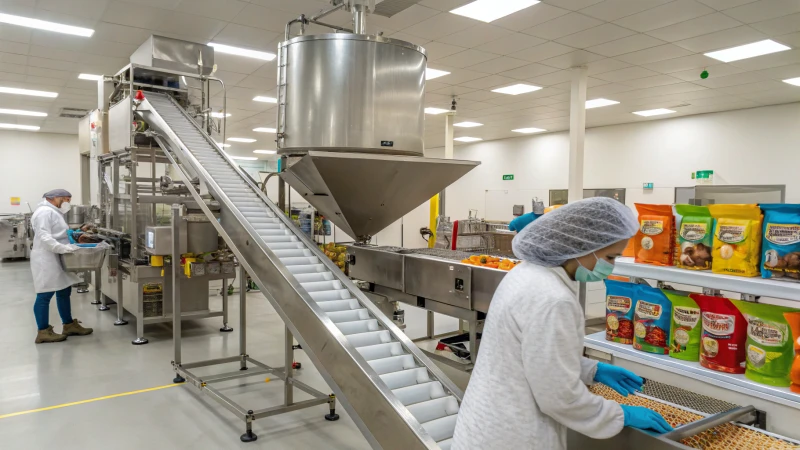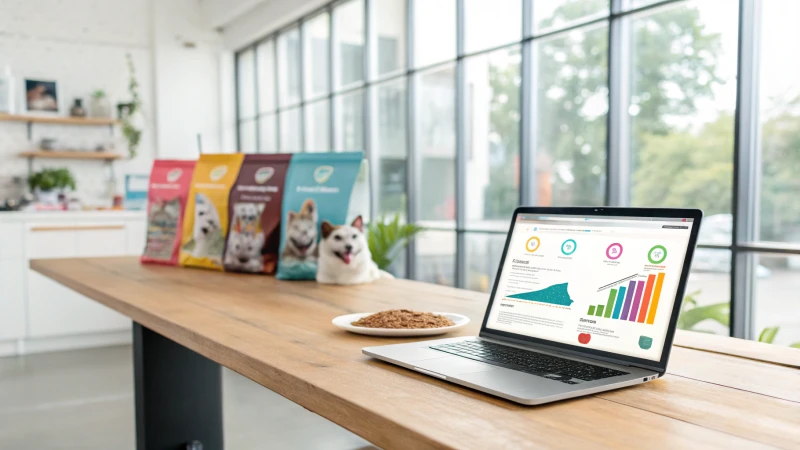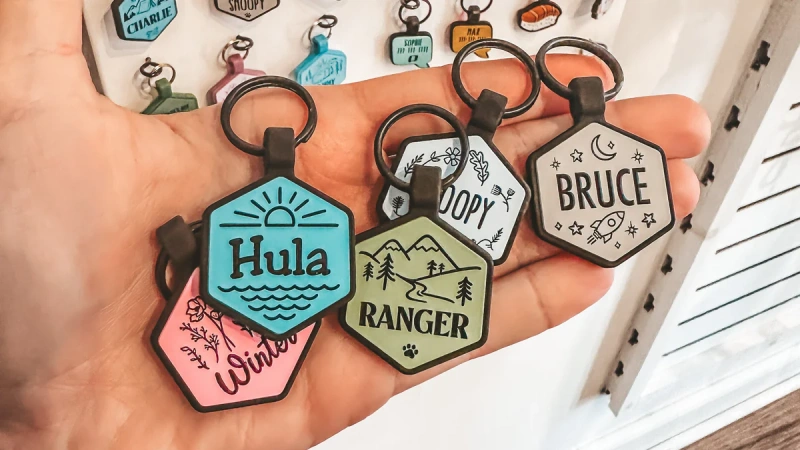
Ever thought about turning your love for pets into a thriving business?
To start a successful pet food manufacturing business, I need to dive into market research, comply with regulatory requirements, secure top-notch ingredient sources, and craft effective marketing strategies. This journey begins with a solid business plan, ensuring food safety compliance, and building a memorable brand identity.
While the initial steps might seem overwhelming, each one is a crucial piece of the puzzle. I remember the thrill of visiting local farms to source quality ingredients, and the satisfaction of finally seeing my brand take shape. Understanding safety regulations was a learning curve, but it’s essential for peace of mind. Carving out a niche in this competitive market requires not just passion but also a strategic approach. Let’s dive deeper into sourcing quality ingredients, meeting strict safety standards, and making your brand stand out in the crowded pet food landscape.
Conducting market research is optional for pet food businesses.False
Market research is essential to understand consumer needs and competition.
Compliance with safety standards is crucial for pet food success.True
Adhering to safety standards ensures product quality and consumer trust.
How Do You Conduct Market Research for Pet Food?
Ever thought about diving into the pet food market? It’s a vibrant world driven by the love we have for our furry friends. Let me walk you through how to get started with effective market research.
Conducting market research for pet food means digging into consumer preferences, sizing up competitors, and spotting market trends. Surveys, focus groups, and sales data are your go-to tools for gathering insights and making smart decisions.

Understanding Consumer Preferences
I remember when I first ventured into the pet food industry. The excitement was palpable, but so was the uncertainty. My journey began with understanding what pet owners truly value. I turned to surveys and questionnaires, leveraging online platforms to delve into dietary concerns1, ingredient preferences, and buying habits. It’s fascinating how much you can learn from a simple question like "What does your pet love the most?"
- Surveys and Questionnaires: Utilize online platforms to gather data on consumer preferences. Ask questions about dietary concerns, ingredient preferences, and purchasing habits.
- Focus Groups: Organize focus groups to gather qualitative data. These discussions can reveal insights into consumer attitudes towards new pet food products.
Focus groups were another goldmine for me. Bringing together passionate pet owners in a room (or virtual space) sparked lively discussions that uncovered deep insights into consumer attitudes towards new products. It was like being part of an exclusive club where everyone was eager to share and learn.
Analyzing Competitors
I quickly learned that keeping an eye on competitors isn’t just smart—it’s essential. Conducting a SWOT analysis helped me pinpoint what others were doing right and where they might be missing the mark. It was like peering behind the curtain of a well-staged play.
- SWOT Analysis: Conduct a SWOT analysis of your main competitors to identify their strengths, weaknesses, opportunities, and threats.
- Product Comparison: Create a table comparing top brands, looking closely at price points, ingredients, and those unique selling propositions that make one brand stand out from the rest.
| Brand | Price | Ingredients | Unique Selling Point |
|---|---|---|---|
| Brand A | $$ | Organic | Grain-free |
| Brand B | $$$ | Natural | High protein |
Identifying Market Trends
Staying ahead of trends was something I had to master quickly. Industry reports were my best friend, providing insights into shifts in market size and emerging trends like sustainable packaging2. But it was social media that truly opened my eyes. Listening to pet owners chat about their latest finds or concerns helped me stay on the pulse of what’s hot and what’s not.
- Industry Reports: Access industry reports to track changes in market size, growth rate, and emerging trends such as sustainable packaging.
- Social Media Listening: Monitor social media platforms to understand what pet owners are discussing. This can highlight trending topics and consumer sentiment.
Utilizing Sales Data
Finally, making sense of sales data was like piecing together a puzzle. By reviewing my own sales metrics and comparing them with industry standards, I could spot patterns and opportunities.
- Sales Metrics: Review your own sales data and compare it against industry benchmarks to identify patterns.
- Customer Feedback: Gather feedback from customers through reviews and testimonials to understand their satisfaction levels with current products.
By weaving these strategies into my business approach, I gained a comprehensive understanding of the pet food market, enabling me to make informed decisions that align perfectly with consumer needs and demands.
Surveys are key to understanding pet food preferences.True
Surveys gather consumer data on dietary concerns and habits.
SWOT analysis is irrelevant for pet food market research.False
SWOT analysis helps identify competitors' strengths and weaknesses.
What Legal Requirements Must Be Met in Pet Food Manufacturing?
Ever wondered how pet food manufacturers ensure their products are safe and legal? Dive into the world of regulations that keep our furry friends healthy and happy.
To manufacture pet food legally, businesses must register, secure licenses, comply with FDA and AAFCO regulations, and maintain strict quality control to ensure safety and compliance.

Business Registration and Licenses
Starting my journey in the pet food industry felt like stepping into a new world. Before I could even think about cooking up my first batch, I had to get my business registered as a legitimate entity. Whether forming an LLC or a corporation, this step was crucial in paving the way for what lay ahead. Securing an FSSAI license—or its equivalent—wasn’t just a formality; it was my ticket to ensuring food safety compliance. And let’s not forget the state veterinary license, which was my assurance that I was respecting all the animal health regulations.
| License | Purpose |
|---|---|
| Business Registration | Establish legal entity status |
| FSSAI License | Ensure food safety compliance |
| Veterinary License | Adhere to animal health regulations |
Compliance with FDA and AAFCO Regulations
When I first dived into understanding the Food Safety Modernization Act3 (FSMA), it felt like deciphering a complex puzzle. As a pet food manufacturer in the United States, complying with FDA guidelines was non-negotiable. Implementing good manufacturing practices (cGMPs) and conducting hazard analyses became part of my daily routine. Sanitary conditions weren’t just about cleanliness; they were about crafting a safe environment for production. Labeling according to AAFCO guidelines4 was another layer of compliance, ensuring everything from ingredient lists to feeding instructions was spot on.
Ingredient Sourcing and Quality Control
Finding the right ingredients was like hunting for hidden treasures. Partnering with reliable suppliers who shared my passion for quality wasn’t always easy, but it was essential. Each ingredient had to meet the nutritional needs of pets while aligning with sustainable practices—a goal close to my heart. Working with a pet nutritionist helped me craft balanced recipes that weren’t just about taste but also health.
Quality control measures were my guiding light, ensuring each product batch met safety standards and regulatory compliance.
Additional Considerations
- Equipment Needs: Selecting the right machinery—mixers, extruders, packaging machines—was critical to matching production capacity.
- Labeling Standards: Following AAFCO guidelines5 ensured clarity in ingredient disclosure.
- Sustainability: Embracing ethical sourcing practices became more than a business strategy; it was a commitment to my consumers and their values.
By meeting these legal requirements, I ensured that my pet food products were not just market-ready but truly safe and compliant, ready to bring joy to pets and peace of mind to their owners.
FSSAI license is required for pet food safety compliance.True
The FSSAI license ensures that pet food meets safety standards.
AAFCO guidelines are optional for pet food labeling.False
AAFCO guidelines are mandatory for accurate and compliant labeling.
How Can You Ensure Compliance with Pet Food Regulations?
I remember the overwhelming feeling of diving into pet food regulations when I started my business. Navigating these waters is essential, not just for compliance, but for the peace of mind that comes with knowing our products are safe and trusted.
To ensure compliance with pet food regulations, I make it a priority to stay updated on FDA and AAFCO guidelines. By implementing good manufacturing practices, conducting regular audits, and maintaining precise labeling, I keep my business aligned with legal standards.

Understanding Key Regulatory Bodies
In the early days of my journey into the pet food industry, I quickly realized the importance of familiarizing myself with the Food and Drug Administration6 (FDA) and the Association of American Feed Control Officials (AAFCO). These organizations guide us through the maze of regulations under the Food, Drug, and Cosmetic Act, helping me define ingredients and ensure nutritional adequacy in my products.
Implementing Good Manufacturing Practices (GMPs)
One lesson I’ve learned is that adopting good manufacturing practices (GMPs) is non-negotiable. These practices are our foundation for maintaining sanitary conditions and quality control. I remember setting up regular training sessions with my team to ensure we all understood these standards. Creating a checklist for GMP adherence was a game-changer—it gave us a clear path to follow.
| Key GMP Components | Description |
|---|---|
| Sanitation | Regular cleaning schedules to prevent contamination |
| Documentation | Maintain records of production processes and audits |
| Training | Continuous education on safety practices for employees |
Accurate Labeling Practices
Labels can make or break us—literally. After a close call with a mislabeling issue, I learned the hard way about the importance of following AAFCO guidelines. Now, I always double-check that ingredient lists are in descending order by weight, nutritional adequacy statements are included, and feeding instructions are clear.
Example Label Elements:
- Ingredient List: Must be in descending order by weight
- Nutritional Adequacy: Statements like "Complete and Balanced"
- Feeding Instructions: Detailed daily intake recommendations
Conducting Regular Audits
Audits have become my go-to strategy for identifying compliance gaps. Scheduling internal audits quarterly keeps us on our toes, while third-party audits offer fresh perspectives. Each audit informs our strategies for continuous improvement.
Sourcing Ingredients Responsibly
Finding reliable suppliers is like finding gold. I regularly review supplier certifications and sometimes even visit their sites to ensure ethical sourcing practices. Collaborating with a pet nutritionist helps me align ingredient choices with regulatory standards while meeting pets’ nutritional needs.
Collaborating with Regulatory Consultants
Having a consultant on board who specializes in pet food regulations has been invaluable. Their insights help align my processes with current laws and prepare for any legislative changes.
Staying informed about regulatory updates and integrating robust compliance measures is not just about safeguarding my business—it’s about building trust with consumers and ensuring their pets’ health and safety. For anyone in this industry, I’d recommend exploring resources from industry experts here7 to stay ahead of the curve.
FDA regulates pet food under the Food, Drug, and Cosmetic Act.True
The FDA enforces regulations to ensure pet food safety and quality.
AAFCO creates laws for pet food manufacturing.False
AAFCO provides guidelines but does not create laws; the FDA enforces them.
How Can I Source Quality Ingredients Efficiently?
Ever wondered how to get the best ingredients for your creations? Let’s dive into practices that ensure your products shine.
To source quality ingredients, focus on forging strong supplier relationships, implementing thorough quality checks, and prioritizing sustainability. These strategies help uphold high standards and satisfy consumer demands.

Building Relationships with Suppliers
In my early days of sourcing ingredients, I learned the hard way that not all suppliers are created equal. I remember a time when a shipment of what was supposed to be premium organic grains arrived, but they were far from fresh. It was a pivotal moment that taught me the importance of building strong relationships with reliable suppliers8. Now, I collaborate only with those who have proven their consistency and quality over time.
Establishing a supplier evaluation system has been a game-changer for me. By regularly reviewing performance metrics like delivery reliability and product quality, I’ve managed to maintain a transparent and efficient supply chain9.
Conducting Rigorous Quality Checks
When it comes to quality checks, I can’t stress enough the importance of rigorous standards. At one point, I discovered through lab tests that an ingredient didn’t meet the required purity levels. That’s when I decided to set up strict criteria for ingredient acceptance, from visual inspections to trial batches.
By developing a checklist that covers parameters like freshness and nutritional value, I’ve been able to consistently enhance my product quality. Partnering with a certified lab for unbiased results has also added an extra layer of assurance.
Emphasizing Sustainability and Ethics
I’ve noticed that today’s consumers are more informed than ever, which means they care deeply about where their products come from. In my sourcing journey, I’ve prioritized working with suppliers who are committed to ethical sourcing10. I look for fair labor practices and environmental sustainability in their operations.
Certifications like Fair Trade or organic labels have become non-negotiable in my books. They not only validate the sustainability of ingredients but also bolster my brand’s image and appeal to eco-conscious consumers.
Utilizing Technology in Sourcing
Technology has truly transformed how I manage my sourcing process. Digital platforms have streamlined communication with suppliers, allowing for real-time shipment tracking. It’s like having eyes on every part of the supply chain without leaving my desk.
Using software with supplier performance analytics11 has enabled me to make informed decisions quickly and address any supply chain hiccups efficiently.
| Best Practice | Benefit |
|---|---|
| Relationship Building | Ensures consistent quality and reliable deliveries |
| Rigorous Quality Checks | Guarantees product safety and compliance |
| Sustainable Sourcing | Enhances brand reputation and meets consumer demand |
| Technology Utilization | Improves efficiency and transparency in the supply chain |
By focusing on these best practices, I’ve been able to maintain the high standards my consumers expect while staying true to my values of quality and responsibility.
Strong supplier relationships ensure ingredient quality.True
Consistent quality is achieved through reliable suppliers with proven track records.
Technology has no role in sourcing ingredients.False
Digital platforms and software enhance efficiency and transparency in sourcing.
How to Develop an Effective Marketing Strategy for Your Pet Food Brand?
Ever wondered how to make your pet food brand shine in a crowded market?
To craft an effective marketing strategy for your pet food brand, zero in on your target audience, utilize digital marketing tools, and create captivating content that underscores the distinct benefits of your products.

Understanding Your Market
I remember when I first dived into the world of pet food marketing, it felt like trying to understand a foreign language. Conducting market research12 became my daily routine. I quickly realized that knowing whether pet owners prefer organic or grain-free options was crucial. I started with surveys and focus groups, and believe me, the insights I gathered were like nuggets of gold. Pet owners are passionate, and understanding what they truly want in their pet food choices helped me tailor my approach.
Defining Your Unique Selling Proposition (USP)
Finding my brand’s USP was akin to discovering a treasure map. Whether it was highlighting our use of organic ingredients or our commitment to animal welfare, it was essential that these values resonated with our audience. Consistency was key—I made sure these aspects were front and center in all our marketing materials.
Utilizing Digital Marketing Channels
Social Media Marketing: Oh, how I learned to love Instagram and Facebook! These platforms became my playgrounds for engaging with pet owners. Sharing user-generated content, like adorable photos of pets loving our products, created a community feel. Using targeted ads13 allowed me to reach specific groups effectively.
Search Engine Optimization (SEO): I became quite the keyword detective! Optimizing our website with phrases like "best grain-free dog food" improved our search engine rankings dramatically. The increase in organic traffic was the cherry on top.
Creating Compelling Content
I started crafting content that both educated and entertained. Blog posts about pet nutrition and videos showcasing product usage became powerful tools in my arsenal. Even launching a YouTube channel focused on pet care tips aligned perfectly with topics like pet health14.
Strategic Partnerships and Collaborations
Building partnerships with veterinarians or pet influencers was like adding rocket fuel to our credibility and reach. Collaborating on product reviews or special promotions not only enhanced our visibility but also encouraged word-of-mouth marketing among their followers.
Measuring Success with Analytics
Tools like Google Analytics became my best friends. Tracking website traffic and social media insights helped me monitor engagement levels closely. Evaluating which strategies worked and tweaking them accordingly ensured we always maximized our impact.
Here’s a sample table of potential marketing channels:
| Channel | Audience Reach | Cost | Engagement Potential |
|---|---|---|---|
| Social Media | High | Medium | High |
| Influencer Partnerships | Medium | High | Medium |
| SEO | Medium | Low | High |
| Email Campaigns | Low | Low | Medium |
By embracing these strategies, your pet food brand can not only reach but deeply connect with your target audience. Let these experiences guide you as you embark on crafting a marketing strategy that’s as unique and effective as your brand.
Market research is crucial for pet food brands.True
Understanding consumer preferences and competitors helps tailor marketing strategies.
SEO is unnecessary for pet food brands' success.False
SEO enhances online visibility, attracting organic traffic essential for brand growth.
Conclusion
Starting a successful pet food manufacturing business involves market research, regulatory compliance, quality ingredient sourcing, and effective marketing strategies to create a standout brand in a competitive industry.
-
Understanding dietary concerns helps tailor pet food products to specific health needs. ↩
-
Sustainable packaging is a growing trend that attracts environmentally conscious consumers. ↩
-
Understanding FSMA is crucial for ensuring compliance with US food safety regulations. ↩
-
Learning about AAFCO guidelines helps in crafting compliant product labels. ↩
-
Learning about AAFCO guidelines helps in crafting compliant product labels. ↩
-
Understanding FDA regulations is crucial for ensuring your pet food products meet legal standards for safety and quality. ↩
-
Consultants can provide expert guidance on aligning your business with ever-evolving pet food regulations. ↩
-
Discovering trustworthy suppliers is crucial for consistent product quality. ↩
-
Effective supply chain management ensures efficient operations and timely deliveries. ↩
-
Understanding ethical sourcing helps align with consumer values and expectations. ↩
-
Using analytics tools aids in monitoring supplier performance effectively. ↩
-
Discover effective techniques to gather insights about consumer preferences in the pet food industry. ↩
-
Learn how to effectively utilize Facebook’s targeting tools to reach potential customers interested in pet products. ↩
-
Understand why focusing on pet health can enhance your marketing strategy and appeal to concerned pet owners. ↩



